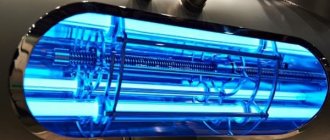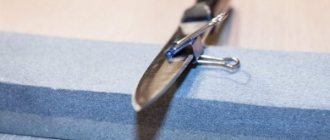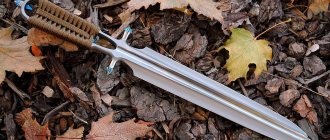The Russian metal market has long been represented by steels and alloys manufactured according to foreign standards: European, Japanese and American. Among them, we can note the AISI 400 series, which meets the standard of the American Steel and Alloy Institute. Steel 440 of this series has received recognition and positive feedback from experts, which has high strength, wear resistance, durability and hardenability and is widely used due to these properties in the manufacture of knives and blades.
Chemical composition of grade 440 steel
Steel strip 440C 250*30*4mm.
From the presented table it can be seen that the main alloying element of the alloy is chromium, therefore, in terms of its chemical composition, steel 440 belongs to the chromium class.
| C | Cr | Mo | Fe | Mn | P | S | Si |
| 0,75-1,2 | 16,0-18,0 | 0,75 | Basic | 1,0 | ≤0,04 | ≤0,03 | 1,0 |
The content of other alloying substances - molybdenum, manganese and silicon - does not exceed 1% for each of the elements. The standard also establishes the maximum amount of phosphorus and sulfur, which are harmful impurities for steels.
Based on carbon content, 440 steel is classified into 3 grades:
- 440A – low carbon (0.65-0.75%);
- 440B – medium carbon (0.75-0.95%);
- 440C – high carbon (0.95-1.20%).
Carbon
The percentage range of this element in the steel composition is quite narrow. In practice, the elasticity of the material is affected by changes in the amount of carbon by hundredths of a percent. The strength and hardness of steel increases with increasing concentration of the element, while the ductility and workability of the material decrease. The optimal carbon content is 1%, like 440C steel.
Manganese
During the steelmaking process, manganese provides protection against oxidation and prevents the formation of sulfides, which improves hardening conditions.
The 1% content of this element in 400 series steels guarantees high resistance to impact and torsional loads.
Chromium
Chromium metal crystals.
The chromium content in stainless alloys is 12-28%. The element provides the anti-corrosion properties of steel, and the carbides formed when interacting with carbon increase hardenability and wear resistance. For grade 440 its content is 16-18%.
Molybdenum and silicon
Like chromium, molybdenum affects the corrosion resistance of stainless alloys. For various types and brands, its content does not exceed 6%. In steel 440 this figure is 1%, which guarantees high strength, wear resistance, hardenability and prevents the formation of hot cracks.
Silicon plays the same role in the composition of steels as manganese: increasing the stability of the alloy and ensuring resistance to cracking. The limiting element content in steel 440 is 1%.
Impurities of phosphorus and sulfur
In metallurgy, these elements are considered harmful technical impurities. The increased content of sulfur and phosphorus negatively affects the mechanical and anti-corrosion properties of alloys and increases their fragility. The maximum amount of such impurities in the composition of steel 440 is no more than 0.03% and 0.04%.
Application area
440C steel contains the maximum amount of carbon, which makes it resistant to corrosion. This quality is enhanced by heat treatment and grinding. Unlike classic stainless steel, this metal is characterized by high levels of hardness, hardenability and wear resistance.
This grade of steel is used in the production of bearings operating in aggressive conditions. It is also used to make various parts that are subject to high demands on strength, wear resistance and corrosion resistance.
Among Russian grades, steel 95X18 has similar properties. Foreign analogues are also produced - AUS-10, N960Co, N690.
Chemical composition of the metal
440C steel is an alloy containing additional components that improve its characteristics. It is highly alloyed, and the main components added during the smelting process are carbon, chromium, manganese, silicon and molybdenum.
Classification of steel by structure
440b grade steel.
In addition to the chemical composition, the technological qualities of alloys are affected by their microstructure, formed during slow annealing. Steels of the 400 series belong to the martensitic class with needle-shaped grains. This crystal structure determines higher strength and hardness compared to other types.
Strength characteristics
In metalworking, the strength characteristics of steels and alloys are used, such as tensile strength, yield strength, relative elongation and hardness on the Brinell or Rockwell scale. The indicator values for the 440 brands included in the series are shown in the table.
| Index | 440A | 440V | 440С |
| Tensile strength, MPa | 740 | 750 | 760 |
| Yield strength, MPa | 420 | 430 | 460 |
| Rockwell hardness, HRC | 56 | 58 | 60 |
| Relative extension, % | 20 | 18 | 13 |
The data presented show that strength properties are better for steels with a higher carbon content. For each grade, they can be increased by heat treatment, but in this case the fragility of the material may increase.
Weldability
Steels of the 440 series are difficult to weld; they are not applicable for the manufacture of welded components and building structures. If necessary, fusion of parts from them is carried out using a special technology. It should contain instructions on the modes of exposure to substances, preliminary and concomitant heating, cooling and heat treatment, on the welding and filler materials used.
Analogs
In terms of their mechanical and technological properties, steels of the 440 series are not exceptional. High-chromium alloys with similar characteristics are manufactured according to European, Japanese and Russian standards.
Steel sheets grade AUS-8.
The European analogue is steel grade 1.4125, the Japanese version is SUS440C according to the JIS standard or grades AUS-8 and AUS-10. Russian ball-bearing corrosion-resistant high-strength martensitic steel 95X18 has the same characteristics.
Normative documents
440 steel is available in three variations:
- 440A;
- 440V;
- 440C.
The letter designations in this case indicate the quantitative content of carbon, which gives the alloy strength and hardness. 440A steel contains the least amount of this component, so this metal is quite flexible. 440C steel contains the most carbon, which is why it is the ideal material for knives and building structures. Otherwise, if you look at the description, the composition of the metals is identical.
The production technology of alloy 440C is regulated by state standards. Rolled metal must meet the following requirements:
- GOST 8509-86 (presented for equal-flange angle bars);
- GOST 8510-86 (for unequal rolled products);
- GOST 8239-72 (for I-beams);
- GOST 19425-74 (for I-beams and special channels);
- GOST 26020-83 (for I-beams with parallel edges);
- GOST 8240-72 (used for channels);
- GOST 19903-74 (for sheet metal);
- GOST 82-70 (for universal-type broadband rolled products);
- GOST 8706-78 (for expanded metal sheets);
- GOST 8568-77 (for sheets with rhombic corrugation).
Also, certain state standard requirements are imposed for bent profiles.
Purpose of alloying components
The term "doping" means "binding" and "joining". The introduction of alloying elements into melts leads to their dissolution in the iron composition and the formation of carbides, intermetallic compounds or unbound inclusions. The correct choice of components and their quantities makes it possible to change the structure and obtain an alloy of various properties and characteristics.
For corrosion-resistant steels, incl. AISI 440, the main alloying element is chromium . In the structure of iron, it forms a solid solution or carbides. When more than 12.5% of this metal is introduced into the melt, a strong protective oxide film of Cr2O3 is formed on the surface of the cooling material.
Molybdenum reacts similarly with the melt of steel 440. In addition, it is capable of forming a fine-grained structure in iron, providing the alloy with high strength and hardness.
Knives of the Ganzo G7321 series.
The function of manganese and silicon as alloying elements is the deoxidation of steel - the binding of dissolved oxygen due to the formation of oxides, which affects the increase in the strength qualities, ductility and hardenability of steel.
Advantages and disadvantages of 440C steel
Any steel has a set of characteristics, which, depending on the area of purpose and application, may individually or collectively have pros and cons for the consumer.
Steel 440C is distinguished by its high performance qualities in the manufacture of cutting tools, incl. knives and blades, as well as bearings, special and medical equipment.
Advantages of 440C steel:
- strength of the material when exposed to loads of different nature and direction;
- high hardness providing resistance to impact loads;
- wear resistance, incl. sharp and sharpened edges;
- corrosion resistance when used in various environments and conditions;
- availability of steel on the market both in the form of rolled metal and in the form of finished products in a wide range.
Knife steel 440C.
The disadvantages of 440C steel are considered conditional, associated with the possibility of finding a more worthy option on the modern supply market:
- not the highest wear resistance for cutting tools, which are achieved by alloying with vanadium and titanium;
- average corrosion resistance to chemically aggressive environments;
- the need for careful care of cutting tools made of steel 440 (this requirement can be extended to any type of special or household equipment).
Choosing steel for a knife
In the last article we examined in detail the types and design of knives. Now let's talk about the best steel for a knife. There are grades of steel that came to the knife industry from conventional industrial production - these are structural and tool steels. IN
According to the method of manufacturing, steel for knives is divided into:
Laminated steel is a welded composite material. Steel coated on both sides with another steel. Harder high-carbon steel is used for the core, and a more viscous or beautiful material, such as Damascus, is used on the facings.
Homogeneous steel is homogeneous, at the macro level, steel. The opposite of damask steel, damask, laminates. To achieve such a high degree of homogeneity, powder technologies are used.
By method of preparation and properties:
- refined
- alloyed
- powder
By chemical composition: martensitic and martensitic-ferritic steels, ferritic steels, austenitic, austenitic-ferritic and austenitic-martensitic steels.
Having peculiar proper names, born of different historical eras and conditions - Damascus steel, damask steel, Japanese tamahagane, “diamond steel”
What is confusing about the general flow of information is that information about the steels used in the production of knives comes from different sources
In addition, some knife manufacturers use special knife steels, steels of their own design or made to order. And, of course, the regional factor also plays here: every major country and region has certain steel grades with their own names and specifications.
However, there are few major major vectors here: the USA, Japan, Europe, China, the countries of the former USSR, Russia.
The overall picture is so voluminous that it’s time to get confused. In order to understand all this diversity, you need to at least briefly, approximately study the most popular steel grades.
Modern Japanese steels
VG series. There are many species in it, the most common is VG-10. VG-10 (short for V-Gold No10) is an alloyed high-carbon corrosion-resistant steel. Specially designed for the knife industry, one of the best knife steels. Occupies an intermediate position between such high-quality steels as ATS-34 and ATS-55.
AUS series. The most common are AUS-8 and AUS-10.
AUS-8 is a corrosion-resistant steel originally developed for making knives. One of the most popular steels due to its ease of processing, maintenance and low cost. The simplest and most affordable steel, among other “Japanese” ones. Of course, such a popular steel also has approximate analogues in other countries: domestic 75Х16МФ and 95Х18, 440 steels, Chinese chrome steels. Some knife lovers claim that the Chinese analogue has already surpassed the Japanese version, of course, provided that the heat treatment process is normal.
AUS-10 steel – knives made of this steel have excellent cutting properties, do not become dull for a long time, but are slightly prone to rusting. Therefore, it is often used with lamination. similar to the American 440C, but unlike it, it contains vanadium, which adds wear resistance.
ZDP. High chromium, ultra high carbon tool powder steel of the highest category. Specially created for the knife industry.
ATS Series. ATS-34 is a high carbon, air hardened chromium stainless bearing steel with high corrosion resistance. Its analogue, up to complete interchangeability, is American steel 154CM. ATS-55. A cheaper version, due to the absence of molybdenum, is ATS-34.
Heat treatment conditions
Depending on the purpose, various types of heat treatment can be used for products made from AISI 440 series steels:
- Before mechanical action, to reduce hardness, annealing is carried out at a temperature of +871...+899°C and with a holding time of up to 6 hours.
- Hot forging is performed at a temperature of +1093...+1160°C and, to achieve maximum hardness, can be completed by hardening, which includes heating to +1010...+1038°C with rapid cooling of the workpiece in water or oil.
- The final tempering mode to obtain a uniform structure depends on the required hardness. The temperature range for this type of heat treatment is +100…+500°C; After exposure, slow cooling of the product must be ensured.











